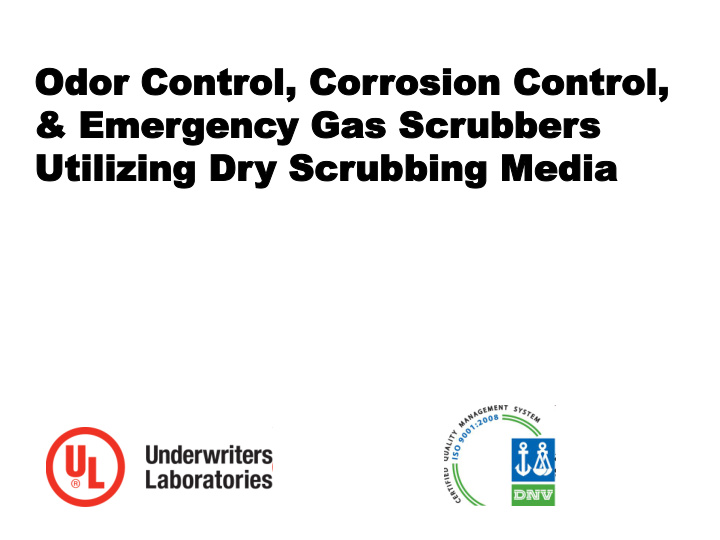



Odor Odor Contr Control, ol, Cor Corrosion Contr osion Control, ol, & Emer & Emergenc gency Gas S y Gas Scr crub ubber bers s Utilizing D Utilizing Dry S y Scr crub ubbing Media bing Media
Applications in Water & Wastewater Facilities Odor Control Corrosion Protection of Electronic Equipment Emergency Gas Scrubbing
What does Gas-Phase mean? • Solids (Particulate) - 0.003 to 100 microns – smoke – dust • Liquids ( & vapors) - 1 to 9 microns – vapors – aerosols • Gases - 0.0003 to 0.007 microns – Hydrogen Sulfide – Chlorine
The Basic Principles: Adsorption: The process by which one substance is attracted to and held on the surface of another. – Adsorption is a surface phenomenon
More Principles... Absorption: The penetration of one substance into the inner structure of another HCHO H 2 S Like A Sponge!
And More Principles... Chemisorption: The result of chemical reactions on and in the adsorbent • This process is specific and depends on the chemical nature of both the adsorbent and adsorbate • This process is essentially instantaneous & irreversible • Oxidation chemically changes harmful gases to harmless solids
Controlling Corrosion to Improve Process Reliability
Types of Corrosion Pore Corrosion: Observed on gold-plated electronic contacts or circuits Creep Corrosion: Corrosion creeps over the gold top plating and forms a nonconductive, insulating film. Whisker Growth: Whisker Growth Microscopic sulfide crystals grow out of the surface of conductive metals.
Even gold-plated electronics can corrode! Acid gases react with metals to form non-conductive salts, which are forced upwards through pores, disrupting the contact.
What is Effected? • Distributive Control Systems -DCS • Motor Controls • Switch Gear • Lab Equipment • Compressors
Design Requirements Instrument Society of America ISA Standard 71.04-1985 Severity G1 G2 G3 GX Mild Moderate Harsh Severe Level Copper Coupon Film 0 - 299 300 - 999 1000 - 1999 > 2000 Thickness (Angstroms) G1 Mild Corrosion not a factor in determining equipment reliability. G2 Moderate Effects of corrosion are measurable and may be a factor in determining equipment reliability. G3 Harsh High probability that corrosive attack will occur. GX Severe Electronic/electrical equipment not expected to survive.
What will G1 Air require? Room Air Purification, with Pressurization(0.10 iwg) and/or Recirculation (6 to 12 ACH) Humidity Control - 55% RH Temperature Control - 70 F Room Construction and Integrity
Typical Large Room Layout Recirculation Unit Outside Air A/C Tub Scrubber or Deep Bed Scrubber
Typical Small Room Layout Outside Air Pressurization and Recirculation Unit A/C
Primary Contaminant Gases Hydrogen Sulfide Chlorine Sulfur Dioxide Methyl Mercaptan
Pressurization and Recirculation Equipment for Smaller Rooms Corrosive Air Unit Positive Pressurization Unit
Electronic Cabinet Unit Attaches Directly to the Cabinet to Provide Positive Pressure, Clean Air to Electronics in Non-Air Conditioned Spaces
Electronic Corrosion Monitoring Uses quartz crystal microbalance technology to measure REAL TIME data of mass gain on copper and silver sensors. Outputs (4 - 20mA) directly to Customers DCS System Copper OnGuard CCT Silver
Typical Large Room Layout Recirculation Unit Outside Air A/C OnGuard CCT Tub Scrubber or Deep Bed Scrubber
Odor Control
Primary Media • Odorcarb Ultra • Odoroxidant • Odormix SP • 35% capacity by • Broad Range • Removes amines, wt. for H 2 S • Works Well for aldehydes, organics, removal mercaptans, and Mercaptans sulfur compounds • 8% Potassium Permanganate Other Medias Available for NH 3 , VOCs, Cl 2
Benefits of Engineered Media Vs. Carbon • Provides Highest Removal Efficiency • 6-9 Times H2S Capacity over Carbon • All Purafil Medias UL Rated, Carbon can Ignite • Chemically Reacts Contaminants, Not Adsorb • Will Not Desorb like Carbon – Hot Humid Conditions can Cause Carbon to Offgas – Carbon is Usually a Hazardous Waste Since it Can Desorb after Disposal • Lower Pressure Drop than Carbon • Can be EASILY Tested for Remaining Life
Applications • Economic Size Range, 100 cfm (200 ppm contaminants) Up To 20,000 cfm (5-10 ppm contaminants) • Applications include - – Headworks – Biofilter Discharge – Primary Scrubber Discharge Polisher – Large Pump Stations – Storage Tanks – Small Lift Stations – Force Main Air Relief Vents
Odor Control – Vessel Scrubber • Ideal for airflows from 8,000 to 20,000 cfm • Use at large headworks, full treatment plants, and large digesters
Typical Installation • Sized for airflows from 1,000 to 6,000 cfm • Use at small headworks, large pump stations, and screening rooms
Odor Control - Deep Bed Scrubber
Deep Bed Scrubber • 3 or 4 pass system used when multiple media are required • Sized for airflows from 1,000 to 8,000 cfm • Use at small headworks, large pump stations, and screening rooms
Odor Control - Drum Scrubbers • 100, 300, 500, and 1000 CFM Sizes • Designed for Existing Odor Problems at Lift Stations • MediaSAKs for Easy Media Replacement
Emergency Gas Scrubbing for Accidental Releases
Fundamentals of Dry Process • Reaction Kinetics Limited – First Order Reaction • Bulk Fill System – Total Required Mass is Present and Available for Reaction Regardless of Load Rate • Reaction Front – Partial Releases Will Only Effect The Media Behind Reaction Front
Chemicals • Caustic • Dry Media – Highly Corrosive – Non Toxic – Toxic/Hazardous – Not Controlled – Controlled – Landfill Accepted – Limited Shelf Life – No Degradation – Secondary Containment
Chlorosorb Ultra • Chlorine Removal • Non toxic/hazardous material before and after reaction • Landfill acceptable • Operates at -40 F.
System Components • Dry • Wet – Vessel/Media – Mass Transfer – Blower Chamber – Sensor – Secondary – Simple Controls Containment – Pumps – Valves – Storage Tank – Nozzles – Blower – Sensor – Complicated Controls
Operation • Reliability and Operation of the Wet Scrubber is Directly Dependent on How Well it is Maintained • The Dry Media EGS is Reliable with Minimal Attention
1-Ton Cl 2 Scrubber
Horizontal, Low Profile EGS
Questions • Thank you for your time Don Apking – North America Sales Manager/ Wastewater
Recommend
More recommend